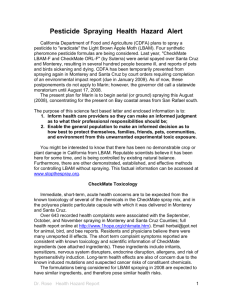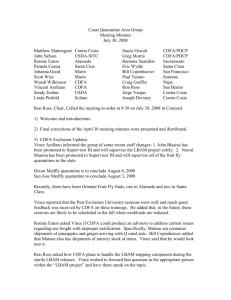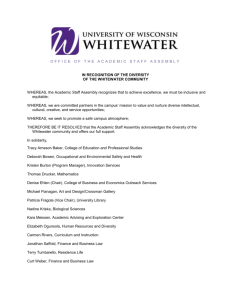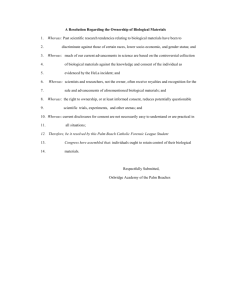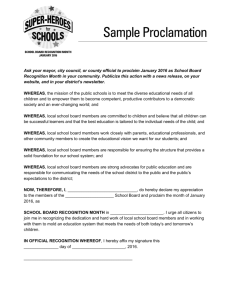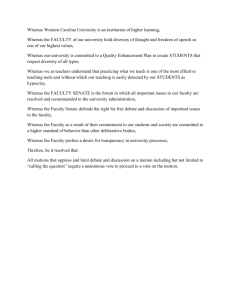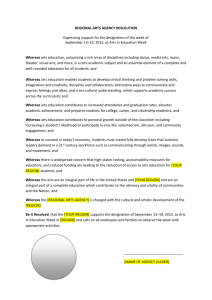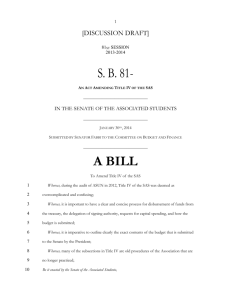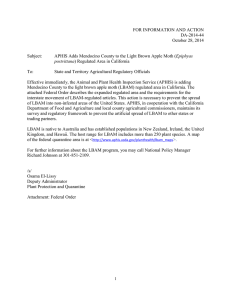Draft Resolution
advertisement
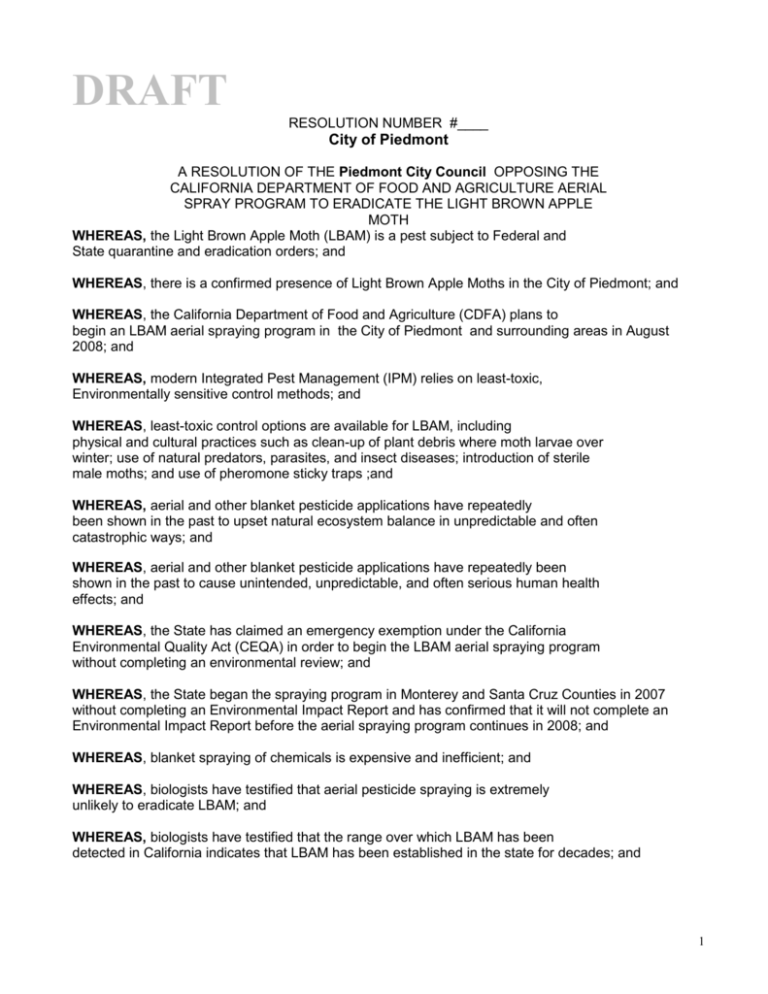
DRAFT RESOLUTION NUMBER #____ City of Piedmont A RESOLUTION OF THE Piedmont City Council OPPOSING THE CALIFORNIA DEPARTMENT OF FOOD AND AGRICULTURE AERIAL SPRAY PROGRAM TO ERADICATE THE LIGHT BROWN APPLE MOTH WHEREAS, the Light Brown Apple Moth (LBAM) is a pest subject to Federal and State quarantine and eradication orders; and WHEREAS, there is a confirmed presence of Light Brown Apple Moths in the City of Piedmont; and WHEREAS, the California Department of Food and Agriculture (CDFA) plans to begin an LBAM aerial spraying program in the City of Piedmont and surrounding areas in August 2008; and WHEREAS, modern Integrated Pest Management (IPM) relies on least-toxic, Environmentally sensitive control methods; and WHEREAS, least-toxic control options are available for LBAM, including physical and cultural practices such as clean-up of plant debris where moth larvae over winter; use of natural predators, parasites, and insect diseases; introduction of sterile male moths; and use of pheromone sticky traps ;and WHEREAS, aerial and other blanket pesticide applications have repeatedly been shown in the past to upset natural ecosystem balance in unpredictable and often catastrophic ways; and WHEREAS, aerial and other blanket pesticide applications have repeatedly been shown in the past to cause unintended, unpredictable, and often serious human health effects; and WHEREAS, the State has claimed an emergency exemption under the California Environmental Quality Act (CEQA) in order to begin the LBAM aerial spraying program without completing an environmental review; and WHEREAS, the State began the spraying program in Monterey and Santa Cruz Counties in 2007 without completing an Environmental Impact Report and has confirmed that it will not complete an Environmental Impact Report before the aerial spraying program continues in 2008; and WHEREAS, blanket spraying of chemicals is expensive and inefficient; and WHEREAS, biologists have testified that aerial pesticide spraying is extremely unlikely to eradicate LBAM; and WHEREAS, biologists have testified that the range over which LBAM has been detected in California indicates that LBAM has been established in the state for decades; and 1 DRAFT WHEREAS, CDFA has stated that no physical crop damage has been attributed to LBAM; and WHEREAS, scientific study indicates that LBAM does no significant biological or environmental damage to crops or wild land plants in New Zealand where LBAM has been an introduced exotic pest for more than 100 years; and WHEREAS, scientific study indicates that LBAM is 80-90% controlled by natural predators in New Zealand and the same “generalist” natural predators are present in California; and WHEREAS, the risk of economic damage alone does not justify the health and environmental risks of aerial pesticide applications; and WHEREAS, the State has relied almost entirely on its own scientists to address public concerns about the LBAM spray program and has not employed independent outside experts to evaluate and support the program or and address issues in a direct and impartial manner; and WHEREAS, the CDFA LBAM spraying program has used pesticides that both State and independent toxicologists have stated have not been tested for long-term human exposure risk and toxicity; and WHEREAS, the CDFA LBAM spraying program is relying on pesticides that contain ingredients that are highly toxic to aquatic life; and WHEREAS, the CDFA LBAM spraying program is relying on pesticides that contain ingredients that are documented to be carcinogenic, mutagenic, reproductive effectors linked to birth defects, liver toxins, dermal irritants, and unsafe to inhale; and WHEREAS, the CDFA LBAM program sprays pesticides in microscopic plastic capsules that pose unknown inhalation risks; and WHEREAS, the CDFA LBAM program sprays pesticides in microscopic plastic capsules that scientific study has shown will be 10 microns or smaller in size, which is small enough to be inhaled to the deep lung and not expelled; and WHEREAS, the California Department of Pesticide Regulation and Office of Environmental Health Hazard Assessment Consensus Document on Health Risks of the LBAM Spray indicates that the State is relying on conclusions drawn from research that assumes that the pesticides to be used for LBAM will be sprayed over agricultural rather than populated urban areas; and WHEREAS, aerial spraying disproportionately affects vulnerable populations such as those who work and play outdoors, those with the recognized disability multiple chemical sensitivity, and those in the homeless population who have no option for protection from the spray or receipt of written notification of spray dates; and WHEREAS, the California Department of Pesticide Regulation and Office of Environmental Health Hazard Assessment Consensus Document on Health Risks of the LBAM Spray acknowledges that the state cannot account for health effects of the pesticides on vulnerable populations such as children, the elderly, and those with chronic diseases; and DRAFT 2 WHEREAS, LBAM aerial spraying in the Santa Cruz and Monterey areas resulted in the spraying of numerous residents and pets; and WHEREAS, hundreds of reports of health effects were reported following the LBAM aerial spraying in Santa Cruz and Monterey counties; and WHEREAS, other environmental impacts were reported following the LBAM aerial spraying in the Monterey and Santa Cruz areas; NOW THEREFORE, BE IT RESOLVED AND ORDERED that the City of Piedmont 1) Opposes the CDFA aerial spray program to eradicate LBAM, and will notify the Governor and other relevant State and Federal officials of this opposition; 2) Requests that CDFA protect the health and welfare of the residents and natural environment of the City of Piedmont by immediately shifting its LBAM control methods to least-toxic Integrated Pest Management methods that include monitoring to determine the true risk posed by LBAM; 3) Requests that CDFA shift its focus to educating the USDA regarding the lack of crop damage done by LBAM, and the need to use least-toxic pest control methods that do not expose populated areas to aerial spraying; 4) Supports adoption by the State of California of the precautionary principle in the LBAM program, and all decision making about pesticide use; 5) Supports, based on up-to-date science, downgrading of the current USDA classification of LBAM as a quarantinable pest, removing the quarantine of areas where the moth has been found in California, and notification of trading partners of this reclassification; 6) Requests that the State conduct a long-term study of the health and environmental effects resulting from the aerial spraying project that has been conducted to date in Monterey and Santa Cruz counties, taking into account reports collected by citizens in the absence of an easily accessible method of reporting to the State; 7) Supports passage of state legislation requiring explicit consent of affected residents before any aerial spray as well as the package of bills (AB 2760, AB 2763, AB 2765, SCR 87, and ACR 117) introduced calling for an immediate moratorium on aerial spray and for other modifications to the State’s aerial spray protocol, including completion of Environmental Impact Report before spraying, disclosure of pesticide ingredients, and invasive species advance planning; 8) Will work with other Bay Area cities and counties to stop the aerial spraying, including exploring joining regional legal action. Signed 3 DRAFT References California Department of Food and Agriculture. 2008. 2008-2009 Light Brown Apple Moth Action Plan. Feb. 8. http://www.cdfa.ca.gov/PHPPS/pdep/lbam/lbam_main.html California Department of Pesticide Regulation and California Office of Environmental Health Hazard Assessment. 2007. Consensus Statement on Human Health Aspects of the Aerial Application of Microencapsulated Pheromones to Combat the Light Brown Apple Moth. October 31. http://www.cdfa.ca.gov/PHPPS/pdep/lbam/lbam_main.html Carey, James, PhD. 2007. Testimony Submitted in Edna Williams, et al., v. California Department of Food and Agriculture, A.G. Kawamura, et. al., Case No. 07-05587, U.S. District Ct. for the Northern District of California. November I4. Carey, James, PhD. 2008. Testimony Submitted to California Assembly Committee on Agriculture, Sacramento CA. March 12. available at: http://democrats.assembly.ca.gov/members/a27/moth.htm Harder, Daniel, PhD. 2007. Testimony Submitted in County of Santa Cruz v. CDFA, Superior Court of California, Santa Cruz County. October 31. Harder, Daniel, PhD and Jeff Rosendale. 2008. Integrated Pest Management for the Light Brown Apple Moth in New Zealand: Implications for California. March 6. available at: http://democrats.assembly.ca.gov/members/a27/moth.htm Material Safety Data Sheet. Butylated hydroxytoluene. Material Safety Data Sheet. Polyvinyl alcohol. Material Safety Data Sheet. Tricaprylmethylammonium Chloride MDL Information Systems, Registry of Toxic Effects of Chemical Substances: Butylated hydroxytoluene; 1,2Benzisothiazol-3(2H)-one; Tricaprylmethylammonium Chloride Philp, Richard B. PhD. 2007. Analysis of Toxicology Studies with LBAM and Related Lepidopteran Pheromones. October. Philp, Richard B. PhD. 2007. Testimony Submitted in County of Santa Cruz v. CDFA, Superior Court of California, Santa Cruz County. October 31. Werner I, Deanovic LA, Markiewicz D. 2007. Toxicity of checkmate® LBAM-F and Epiphyas postvittana pheromone to Ceriodaphnia dubia and fathead minnow (Pimephales promelas) larvae. Aquatic toxicology laboratory. University of California, Davis. 4
